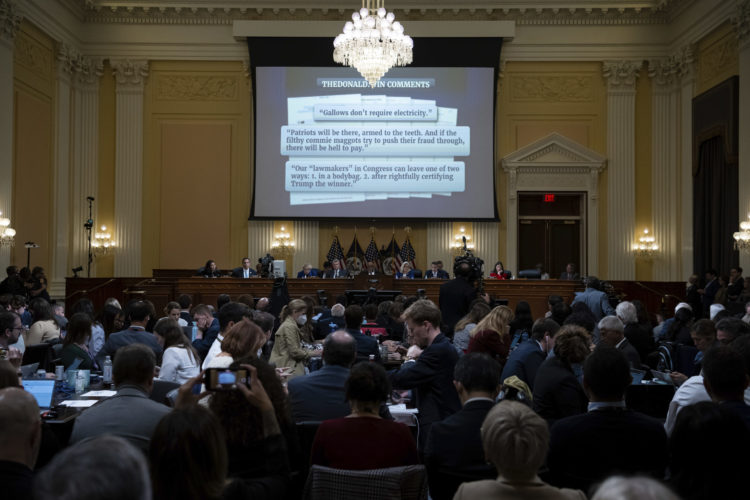The headlines coming out of last week's public hearing of the Congressional Select Committee investigating the Jan. 6, 2021, attack on the U.S. Capitol focused on the unanimous vote to issue a subpoena to a former president requiring his testimony under oath. The formal vote was still a good 90 minutes away when the news broke, but journalists, pundits, lawyers and political analysts were singing in chorus: The likelihood of Donald J. Trump showing up is a decimal point above nil. But it shows the confidence in what the committee found in 15 months of digging, puts it on the record for history and may be a doorway for the Department of Justice which, unlike the committee, has the ability to bring criminal charges.
No matter what happens next, one thing has been from the beginning of the committee's work: The primary audience for these hearings has been the American public.
As a study in story, the second half of last week's hearings — possibly the last — are worth watching: Footage from inside the lock-down areas where congressional leaders — Democrat and Republican — were scrambling for a way to re-secure the Capitol and resume the formal vote making Joseph R. Biden president. In months and months of hearings built along a dramatic arc, this was quite the kicker: No drift of this story at the end.
I'm a long-ago student government officer and a momentary wannabe lawyer. In high school, I imagined someday serving as White House press secretary. A Socratic college education and the mean streets of racially-divided Milwaukee brought me to my senses and a life in journalism. But I still respect the tedious bureaucratic processes that dictate our democracy (Robert's Rules of Orders!); used right, they avoid chaos while moving things (slowly) forward. Enforced throughout the hearings by Mississippi Congressman Bernie Thompson, who chairs the committee, those rules created transitions and an understated tone that became calm structural devices — here's where you are, dear reader, and here's where you're going next — that never distracted from the underlying narrative.
It's that narrative — the heart of the story — that I keep noting from my Storyboard perch. Earlier this year, I annotated a piece by New York Times TV critic James Poniewozik that praised the storytelling evident in the committee's public work. Yesterday, for the close, all nine of the committee members had a spoken role, like a team of reporters writing sections of a multi-bylined story for a clear-eyed editor who brought cohesion to the whole. Moment by moment, source by source, scene by scene, they built the case for a nation, constitution and ideal under existential assault. It was charged but legalistic, almost detached in tone.
Which may be why one line stood out, not for any uncontrolled emotion but for its clarity of purpose. As Thompson brought the hearings to a close, he also brought the unspooled narrative full-circle, answering the question that has framed the committee's investigation: What was Trump's role and responsibility in the Jan. 6 attack? In other words, who was the main player in this story?
Thompson's answer: Trump. "He is the one person at the center of the story of what happened Jan. 6."
Politics aside, if that's remotely possible these days, this is model story work, and I mean story in the true, credible, vetted, nonfiction sense: Relentless reporting — more than 1,000 interviews and depositions, more than 100,000 pages and documents reviewed; an episodic structure than never lost focus; carefully chosen and tightly edited scenes and quotes; transparent sourcing, and a clear sense of audience.
No matter what happens next, one thing has been from the beginning of the committee's work: The primary audience for these hearings has been the American public.
As a study in story, the second half of last week's hearings — possibly the last — are worth watching: Footage from inside the lock-down areas where congressional leaders — Democrat and Republican — were scrambling for a way to re-secure the Capitol and resume the formal vote making Joseph R. Biden president. In months and months of hearings built along a dramatic arc, this was quite the kicker: No drift of this story at the end.
I'm a long-ago student government officer and a momentary wannabe lawyer. In high school, I imagined someday serving as White House press secretary. A Socratic college education and the mean streets of racially-divided Milwaukee brought me to my senses and a life in journalism. But I still respect the tedious bureaucratic processes that dictate our democracy (Robert's Rules of Orders!); used right, they avoid chaos while moving things (slowly) forward. Enforced throughout the hearings by Mississippi Congressman Bernie Thompson, who chairs the committee, those rules created transitions and an understated tone that became calm structural devices — here's where you are, dear reader, and here's where you're going next — that never distracted from the underlying narrative.
It's that narrative — the heart of the story — that I keep noting from my Storyboard perch. Earlier this year, I annotated a piece by New York Times TV critic James Poniewozik that praised the storytelling evident in the committee's public work. Yesterday, for the close, all nine of the committee members had a spoken role, like a team of reporters writing sections of a multi-bylined story for a clear-eyed editor who brought cohesion to the whole. Moment by moment, source by source, scene by scene, they built the case for a nation, constitution and ideal under existential assault. It was charged but legalistic, almost detached in tone.
Which may be why one line stood out, not for any uncontrolled emotion but for its clarity of purpose. As Thompson brought the hearings to a close, he also brought the unspooled narrative full-circle, answering the question that has framed the committee's investigation: What was Trump's role and responsibility in the Jan. 6 attack? In other words, who was the main player in this story?
Thompson's answer: Trump. "He is the one person at the center of the story of what happened Jan. 6."
Politics aside, if that's remotely possible these days, this is model story work, and I mean story in the true, credible, vetted, nonfiction sense: Relentless reporting — more than 1,000 interviews and depositions, more than 100,000 pages and documents reviewed; an episodic structure than never lost focus; carefully chosen and tightly edited scenes and quotes; transparent sourcing, and a clear sense of audience.



